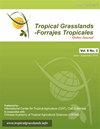Influence of plant population density of Chamaecrista rotundifolia on its value for hay making in the Eastern Amazon, Brazil
IF 0.7
4区 农林科学
Q3 AGRICULTURE, DAIRY & ANIMAL SCIENCE
引用次数: 0
Abstract
Chamaecrista rotundifolia is a forage legume little used with Brazilian livestock; however, it has been studied for this purpose for over 40 years in Australia. The aim of this study was to characterize the influence of plant densities of approximately 444,400, 111,100 and 27,800 plants/ha (equivalent to spacings of 0.15 × 0.15; 0.30 × 0.30 and 0.60 × 0.60 m) on quantitative and qualitative parameters of C. rotundifolia grown in pure stands as forage under exclusive cropping for hay. While leaf dry matter yields in the first 93 days after planting ranged from 1.48 to 9.32 t DM/ha, declining to 0.71–4.92 t DM/ha in the subsequent 83 days, crude protein concentration of the material was only 7–8%. Since this species tends to lose leaf during periods of stress, larger paddock studies are needed to determine how well leaf material is retained under conventional hay-making conditions. Optimal stubble height following harvesting should be investigated in an endeavor to increase DM yields at second harvest along with improved survival of plants.巴西东亚马逊圆叶Chamaecrista的种群密度对其干草价值的影响
圆叶Chamaecrista rotundifolia是一种很少用于巴西牲畜的饲料豆类;然而,澳大利亚已经为此目的研究了40多年。本研究的目的是表征约444400、111100和27800株/公顷(相当于0.15×0.15、0.30×0.30和0.60×0.60 m的间距)的植物密度对圆叶C.rotundifolia在纯林中作为干草专用种植下的饲料的定量和定性参数的影响。虽然种植后前93天的叶干物质产量在1.48至9.32 t DM/ha之间,在随后的83天下降到0.71至4.92 t DM/ha,但材料的粗蛋白浓度仅为7-8%。由于该物种在胁迫期间往往会落叶,因此需要进行更大规模的围场研究,以确定在传统干草制作条件下叶片材料的保留情况。应研究收割后的最佳残茬高度,以努力在第二次收割时提高DM产量,同时提高植物的存活率。
本文章由计算机程序翻译,如有差异,请以英文原文为准。
求助全文
约1分钟内获得全文
求助全文
来源期刊

Tropical Grasslands-Forrajes Tropicales
Agricultural and Biological Sciences-Agronomy and Crop Science
CiteScore
1.60
自引率
0.00%
发文量
36
审稿时长
16 weeks
期刊介绍:
The Journal publishes, in English or Spanish, Research Papers and Short Communications on research and development, as well as contributions from practitioners (Farmer Contributions) and Review Articles, related to pastures and forages in the tropics and subtropics. There is no regional focus; the information published should be of interest to a wide readership, encomprising researchers, academics, students, technicians, development workers and farmers.
In general, the focus of the Journal is more on sown (''improved'') pastures and forages than on rangeland-specific aspects of natural grasslands, but exceptions are possible (e.g. when a submission is relevant for a particularly broad readership in the pasture and forage science community).
The Journal will also consider the occasional publication of associated, but closely related, research in the form of an additional scientific communication platform [e.g. a re-make of the former Genetic Resources Communication series of the former Division of Tropical Crops and Pastures of the Commonwealth Scientific and Industrial Research Organisation (CSIRO), Australia].
Areas of particular interest to the Journal are:
Forage Genetic Resources and Livestock Production[...]
Environmental Functions of Forages[...]
Socio-economic Aspects[...]
Topics within the aforementioned areas may include: Diversity evaluation; Agronomy; Establishment (including fertilization); Management and utilization; Animal production; Nutritive value; Biotic stresses (pests and diseases, weeds); Abiotic stresses (soil fertility, water, temperature); Genetics and breeding; Biogeography and germplasm collections; Seed production; Ecology; Physiology; Rhizobiology (including BNF, BNI, mycorrhizae); Forage conservation; Economics; Multilocational experimentation; Modelling.
 求助内容:
求助内容: 应助结果提醒方式:
应助结果提醒方式:


